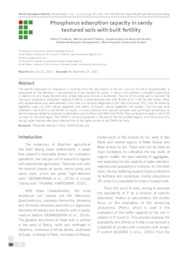Phosphorus adsorption capacity in sandy textured soils with built fertility.
Phosphorus adsorption capacity in sandy textured soils with built fertility.
Author(s): FONTANA, A.; PEREIRA, M. G.; SANTOS, J. J. S. dos; DONAGEMMA, G. K.; SANTOS, O. A. Q. dos
Summary: The specific adsorption of phosphorus in minerals from the clay fraction of the soil, such as Fe and Al oxyhydroxides, is responsible for the decrease in the availability of this element for plants. In Brazil, this condition is studied substantially in medium to very clayey textured soils, whose adsorption activity is expressive. The aim of this study was to evaluate the maximum phosphorus adsorption capacity (CMAP) in sandy-textured soils with fertility built in the Cerrado biome. Areas with representative soils were selected in the cities Luís Eduardo Magalhães (LEM / BA) and Guaraí (TO), with the following vegetation cover: a) LEM: natural vegetation and cotton; b) Guaraí: natural vegetation and soybean. Soil samples were collected in the 0-20 cm and 60-80 cm layers, in which chemical and physical analyzes were performed periodically, as well as analyzes related to phosphorus adsorption such as Prem and CMAP and PESN. Prem contents are higher in the 0-20 cm layer for the LEM region. The CMAP is not very expressive in the soils of the two studied regions, with the Guaraí soils having higher relative adsorption potential due to the higher values of the CMAP/clay ratio.
Publication year: 2021
Types of publication: Journal article
Unit: Embrapa Soils
Keywords: CMAP, Fosfato, Fósforo, Phosphate retention, Prem, Sandy soils, Solo Arenoso
Observation
Some of Embrapa's publications are published as ePub files. To read them, use or download one of the following free software options to your computer or mobile device. Android: Google Play Books; IOS: iBooks; Windows and Linux: Calibre.
Access other publications
Access the Agricultural Research Database (BDPA) to consult Embrapa's full library collection and records.
Visit Embrapa Bookstore to purchase books and other publications sold by Embrapa.

